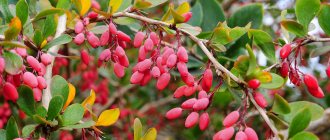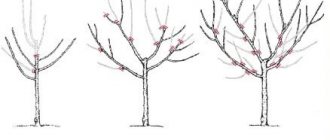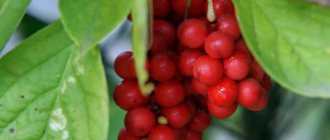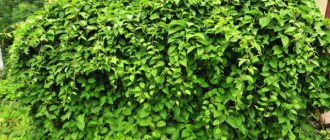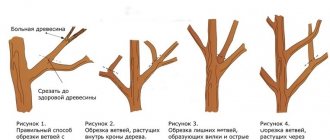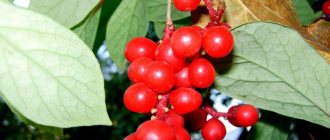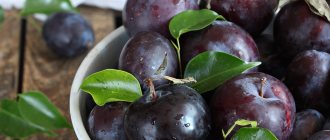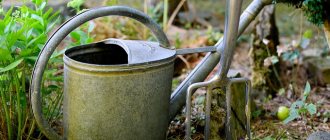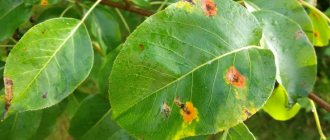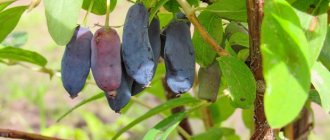Adult lemongrass plants require thinning pruning, since it is pollinated mainly by the wind and excessive thickening reduces the yield.
Time to prune lemongrass.
In early spring and during the period of active spring sap flow, pruning of lemongrass should not be carried out. Plants bleed juice, become weak and may die. At this time, pruning, pinching and mechanical damage to the shoots cause the awakening of buds on the shoots of the current year. The resulting young branches do not have time to ripen and become woody, so they die after the first frost.
Therefore, pruning of lemongrass is carried out during flowering, immediately after it and in late autumn after leaf fall. During this period, plants are formed and thinned, weakened or drying branches are cut out.
The structure of a lemongrass bush.
An adult vine has three types of shoots that perform different functions and differ from each other in growth strength - growth, mixed and fruiting.
Growth shoots are supporting, this is the skeleton of the vine. Growth shoots grow from dormant buds of two-year-old (or older) wood. During the growing season they grow up to 2-3 meters in length. These shoots always end with a sharp, immature tip, which dies in winter. A distinctive feature of such shoots is a large percentage of the core, long internodes and large leaves.
Mixed shoots are formed from buds on growth from the previous year. They reach a length of 50–80 cm, curl and end with a blunt tip. These shoots are both supporting and fruit-bearing (the harvest is concentrated at the base of the shoots).
Fruit shoots are formed on one-year-old wood (third-order shoots). In the shade, the fruit shoots dry out after fruiting, but in the sun they remain viable and form fourth-order branches, which next year will bear fruit abundantly with smaller berries. Fruit shoots are not capable of twining around a support. Their length does not exceed 10 cm, they end with a blunt apex, the internodes are shortened. The main function of fruit shoots is fruiting.
Pruning when planting lemongrass.
When planting, the tops of lemongrass seedlings are pinched so that the dormant side buds wake up.
Regular pruning of mature lemongrass.
When pruning an adult lemongrass, remove thin and broken shoots, as well as weak ones that thicken the crown. They cut out branches that have bear fruit for three years in a row (it is not necessary to cut the vine all the way to the ground; you can cut it down to a powerful young vine located lower to the ground).
Growth shoots can be shortened to the desired length.
Mixed shoots are trimmed, leaving about 30 cm in length.
All shoots remaining after pruning are evenly distributed on the support.
Forming lemongrass on a flat trellis in a fan shape.
After planting the lemongrass in a permanent place, the seedling is pruned, leaving 2-3 buds on each shoot. The next year, 2-3 vertically growing long shoots are chosen; these are the main branches of the fan. The rest are cut down to the ground. After the leaves fall off, the top of the remaining shoots is removed to the level of mature wood (or the apical bud, if it has formed).
In the third year, lateral shoots grow from the main shoots. In summer, the most powerful ones are selected and tied horizontally to the trellis, pointing in different directions. Pruning and pinching at this time are used to maintain optimal density and the desired length of the branches.
In the spring of the fourth year, shortened fruiting and mixed shoots are formed. They are tied vertically to the trellis.
In the fifth year, the strongest ones are again selected from the shoots growing on them and tied horizontally to the second wire, pointing in different directions. Fruit-bearing shoots are shortened every year, leaving 4-5 buds above the topmost berry. The cuts are covered with garden varnish.
In subsequent years, pruning lemongrass is reduced to thinning and removing dead branches.
Pruning Schisandra chinensis in autumn
Pruning Schisandra chinensis
Not only its future fruiting, but also the decorative design of the garden plot depends on competent and correct pruning of Schisandra chinensis.
In this regard, the vines of this fruit plant sometimes need to be significantly shortened. As a rule, this procedure is carried out only twice a year, namely in the summer and autumn months. Autumn pruning of Schisandra chinensis involves the removal of weak, dried out and excess shoots that have formed over the summer period. It is worth noting that it is necessary to prune such branches only after all the leaves of the plant have fallen off and it has gone into a dormant state.
In addition to weak shoots, in the fall it is recommended to prune that part of the vine that has actively bear fruit in the last three years. This is necessary so that younger vines can fully develop and produce a lot of harvest.
As a rule, the growth shoots of Schisandra, which form the entire skeleton of the plant, can be shortened to the desired length, but with mixed branches such actions are unacceptable. This is due to the fact that such growths are younger shoots, which will definitely bear fruit in the summer season. That is why in the fall they can be removed by only 30 centimeters.
Summer pruning of Schisandra chinensis is resorted to only when the vines begin to thicken the trellis too much with new shoots. In this case, experts recommend cutting the branches of the plant approximately ten to twelve buds from the edge.
In addition, it is necessary to remove the root shoots of lemongrass every year and replace old vines with younger ones. However, what is meant about shoots is not their significant age, but the degree of their exposure and distance from the base.
In order to correctly prune Schisandra chinensis, it is necessary to take into account not only the method of forming its crown, but also many other nuances that only an experienced specialist can know. provides the services of just such professionals, thanks to whom your garden plot will be decorated in the best possible way. After all, only competent pruning of bushes and trees will contribute to both a bountiful harvest and the creation of an attractive appearance of the garden. We are ready to provide you with the best specialists who will come to any district of Moscow and the Moscow region.
If you find an error, please select a piece of text and press Ctrl+Enter.
Schisandra chinensis, cultivation and care
Schisandra chinensis, the cultivation and care of which requires compliance with certain conditions, is gaining great popularity among gardeners, the benefits and healing properties of which are difficult to overestimate for the human body. It is quite easy to grow wonderful vines in your dacha; you only need a little knowledge and the desire to have a beautiful plant in the garden.
Care on cold days of the year
In general, lemongrass does not require any special care or pruning, but in late autumn and winter only thickened or dried vines should be removed. A prolonged lack of rain requires weekly watering.
Schisandra shelter for the winter
In winter, the roots of lemongrass can be protected from freezing if they were watered and mulched with dry leaves or peat in the fall. The most important thing in caring for this plant is to provide it with reliable support. If this is not done, a lack of fruit may occur.
In winter, you can remove the vine from the supports, but you must consider the following:
- this is not easy to do because the stems wrap tightly around the support;
- in natural conditions, lemongrass manages to perfectly tolerate the most severe frosts without additional shelter.
If desired, the soil under the vines can be additionally mulched for the winter by adding humus. You can also simply remove fallen leaves from under the plant, since lemongrass is prone to shedding them.
As practice has shown, the plant in question is more sensitive to late frosts than to winter frosts. In fact, such a recurrent phenomenon does not occur in our country. However, spring cold can harm both flowers and buds, which can cause a lack of harvest.
I have long wanted to “get” lemongrass in my yard. I have heard about its benefits and pleasant refreshing lemon taste. However, this mysterious “Chinese” is a little scary: where is China, and where are we? However, after reading about planting Chinese lemongrass and caring for it, it became clear that there would be no problems with the Chinese :) Everything is clear and not difficult.
Schisandra chinensis seedlings – how to choose?
You can grow a beautiful, powerful vine and achieve fruiting only after successfully purchasing seedlings and properly planting lemongrass. For planting, healthy bushes of two or three years of age with roots of at least 20-25 centimeters are selected. When purchased, the roots of the plant must be moist and without visible damage.
If Chinese lemongrass seedlings are sold together with a lump of earth, this is even better; the plant will be less susceptible to stress when transplanted to a permanent place. The bark of young vines should be smooth; wrinkled cover may indicate a lack of moisture in the plant and improper storage.
During transportation, the roots are wrapped in a damp cloth or plastic bag and transported in this state, especially if the plant is transported over long distances. If the roots of the plant were a bit dry when sold, but in general, after a visual inspection, they look strong and vigorous, place the lemongrass in water for 10-12 hours to saturate the roots and the plant with moisture. Root formation stimulants (Epin, Zircon, etc.) can be added to the water; lemongrass will quickly recover from stress and restore vital processes.
Planting seedlings - taking into account the nuances and preparing the place
How to grow Schisandra chinensis, how is the wonderful vine planted? Planting Chinese lemongrass is a quick and easy process, you just need to properly prepare the soil and planting hole. Place the plants on the south side of the plot; lemongrass does not grow well in drafts and shade. It is not recommended to plant the vine near buildings or outbuildings that create shade; if necessary, 1.5-2 meters are removed from the structures.
in the photo - seedlings of Schisandra chinensis
in the photo - a planted Chinese lemongrass seedling
When to plant Schisandra chinensis? The timing of planting seedlings is in the months of September and October; a vine can also be planted in early spring (preferably for the northern regions, in the Urals, in Siberia, where frequent early frosts in the fall can destroy the plant).
The soil for planting should be loose and preferably with drainage. Dig a hole 0.4-0.5 meters deep and 50-60 centimeters wide, and pebbles, broken bricks or slate are placed at the bottom of the hole. Then pour in a fertile mixture (turf soil, compost or humus), place the seedling vertically and cover it with the remaining fertile soil mixture. When planting, the root collar of Chinese lemongrass should be 5-4 centimeters above ground level. Then the plant is thoroughly watered (2-3 buckets of water per bush will be enough).
When planting several schisandra seedlings, the plants are spaced 1.3-1.5 meters apart, leaving a row spacing of 2.2-2.5 meters. It is advisable to plant at least two vines with different varietal characteristics; this technique allows you to increase the yield of Chinese lemongrass several times.
Correct bush formation
Schisandra can be grown in two forms - bush or vine. The latter is used most often, because the branches of the plant receive the maximum amount of light and the conditions for pollination of flowers are improved. At the same time, the length of the stems, weight and yield increase. The weight of the fruit on a vine can reach 9.8 g, while in bush form it is about 3.5 g. In this case, the vines develop better and in this case it is easier to shape the appearance of the plant.
To give the vine the correct shape, lemongrass begins to be pruned at 2-3 years of age. By this time, the root system is no longer actively developing, and the above-ground part enters an active growth stage. Of the numerous shoots, for better fruiting, it is recommended to leave about 2-3 pieces, which will serve as the main branches of the fan. The rest should be removed at the root.
The next year, side shoots begin to form on the bush. The most powerful of them should be fixed horizontally on a support. In this way, the desired density of lemongrass is formed for greater yield. After another year, fruit-bearing shoots of a mixed type grow. They must be fixed vertically. Later, the most powerful ones are selected and also tied to a support.
After fruiting, the shoots are pruned, leaving 4-5 buds above the top berry, and the main pruning in the following years comes down to removing dead branches. The decorative appearance and fruiting of the plant depend on correct pruning. It is recommended to shorten the formed vine twice a year so that it produces young shoots in the next season.
Schisandra chinensis - planting seeds
Growing Chinese lemongrass from seeds is also possible; propagation by seeds is carried out in April and May, but before sowing, the seeds must be stratified. In autumn, seed material is mixed with moistened sand and stored at a temperature of 5-7 ° C above zero (at home it can be stored in the refrigerator). Once every 14 days, take out the seeds with sand and ventilate them, not forgetting to mix.
60 days before sowing the seeds (in February, March), the container with seedlings is transferred to a warm room (t +20°C) for one month. Then for 30 days the temperature is reduced to +8°C. The sand must remain moist throughout the entire stratification period.
in the photo - Schisandra chinensis seeds
Sowing the seeds of Schisandra chinensis is carried out in previously prepared grooves 20 mm deep in moist soil diluted with sand (1:1). After sowing, the furrows are filled, slightly compacting the soil, mulched with peat crumbs and sand (1:1) in a small layer (2-2.5 cm), then watered. It is advisable to equip the garden bed in a greenhouse. Watering is required rarely, only on hot days in the morning.
After each watering, it is advisable to shake off excess water from grown plants by running your palm over the lemongrass leaves, allowing the leaves to dry completely. This approach allows you to protect young sprouts of Chinese lemongrass from rot. High humidity and high air temperatures are detrimental to young seedlings. It is recommended to keep the leaves dry. For better ventilation of the sprouts, do not sow the seeds of Schisandra chinensis too thickly.
For the winter, grown plants in a greenhouse do not require shelter. Next year, Chinese lemongrass seedlings are planted in a permanent place. Typically, seedlings grown from seeds in this way are equivalent to four-year-old vines.
How to properly cover peonies
The plant has such an important feature as the very close location of the growth buds to the soil surface. Considering this circumstance, flower growers carefully prepare the flower for wintering. Peonies are not covered only in the southern regions, where they tolerate winters well.
The growth buds that formed in the autumn are located in the ground only 3-7 cm deep. In places where there are frosty winters, the plant is earthed up in the fall before frost sets in.
Also, to cover the peonies, you should prepare mulch in advance. Suitable for this:
- peat;
- wood shavings;
- spruce branches;
- dry leaves;
- grass.
The bush is covered with a layer of mulch about 15-20 cm high. Such insulation will protect the plant from any frost until the onset of warmth.
In winter, it is necessary to monitor the condition of the bushes. If there is insufficient rainfall, you need to collect snow and cover the area with flowers with it. This will be an additional measure to preserve plants in winter frosts.
How to care for lemongrass?
Chinese lemongrass, the cultivation of which is not so difficult, still requires the fulfillment of a number of criteria. In order for the vine to quickly become stronger and grow, take care of feeding the young plant. Young lemongrass is fertilized according to the following scheme; in the spring, 4 tsp are added to the tree trunk circle. ammonium nitrate and mulch with compost (humus).
in the photo - Schisandra chinensis
in the photo - harvest of Schisandra chinensis
Until August, in the summer, organic fertilizer for Chinese lemongrass is applied in liquid form every 7-10 days. Liquid fertilizing, according to experienced agronomists involved in growing Schisandra chinensis, is most effective for young vines. A solution of mullein is prepared at a rate of 1:30 and watered over the plants; chicken manure is diluted in the same way.
When Chinese lemongrass begins to bear fruit, such frequent feeding is stopped and the vines are fertilized only as needed (usually once a year in the fall). Schisandra is not afraid of withering. All fertilizers for an adult plant are reduced to mulching with compost (5-7 cm) or fallen leaves (15-20 cm). By creating just such conditions, the future harvest is laid, and not the growth of shoots.
In a state of slight stress, the plant intensively begins to lay more female inflorescences, preparing to reproduce by seeds, and not by root shoots, this is the whole secret of the productivity of Chinese lemongrass. If an adult vine is fed frequently, new vines with male flowers will actively grow.
The young vine requires fairly frequent watering; the soil should not be allowed to dry out completely. Lack of moisture leads to the leaves of Chinese lemongrass turning yellow and withering; light green or brown spots also appear on the leaves; sometimes the edges of the leaves become brown. An adult plant that has entered fruiting is watered only when the foliage withers in the summer.
When caring for vines, you need to know how to properly prune Chinese lemongrass; dense thickets lead to a lack of flowers, and therefore the plant does not bear fruit. There is no nectar in the flowers; pollination occurs mainly by wind in dry weather. Male flowers are located at the bottom of the vines, female flowers at the top; pollen needs to rise up to set fruit. Without pruning, it is impossible to meet these conditions; through dense foliage, pollination occurs poorly or does not occur at all, as a result, fruits are not formed from Schisandra chinensis.
in the photo - caring for Chinese lemongrass
In early spring, thinning pruning must be carried out to ensure proper formation of the plant, removing all intertwined tops and shoots, dry and frozen branches. Second-order vines (those that grow from the main central stems) are recommended to be shortened by 25-30 centimeters.
When growing vines, be sure to take care of support; without a trellis, fruiting will be poor. Do not allow the vine to grow, dig out all excess cuttings, and keep the plant within the perimeter of the trellis. Limiting the nutrition of the roots within the trellis will force Chinese lemongrass to reproduce by seeds, thus we specifically create conditions for the formation of more flowers.
When caring for a wonderful plant, it is important to remember that the soil in the tree trunk circle is not loosened; the roots, which are located at a shallow depth, are damaged; it is recommended to mulch with humus or compost. To make Chinese lemongrass bear fruit as early as possible and reap a good harvest of fruits, you must follow the basic golden rules:
It is not advisable to plant seedlings in quantities of at least two; it is not advisable to propagate by layering. When planting, keep an eye on the root collar, which should not be buried in the ground, but should be 5-7 centimeters above the soil surface. The recommended width of the support (trellis) for lemongrass along with above-ground shoots is 0.3 meters Young vines need watering and fertilizing. Chinese lemongrass must be pruned. After fruiting begins, fertilizing and watering are limited, preventing the plants from “fattening”.
11 rules for growing lemongrass in the country
Stefan NEDYALKOV 03/22/2014 | ਁ4133
Growing lemongrass in your summer cottage is quite simple. But if you want the plant to produce a truly good harvest of berries, follow the suggested tips.
The composition of the soil should be as close as possible to natural. I have lemongrass growing along the fence in sandy soil. Moisture on the surface never stagnate. If there are no such conditions, then you need to make good drainage and build a high bed. Due to the fact that clean sand is infertile, and the root system of Schisandra is located mainly superficially, until August, every 7-10 days I feed young plants (before fruiting) with diluted organic matter. At the same time this is also watering. I pay special attention to the color of the leaves . If they acquire a light shade, then the plant needs to be shaded a little. In general, the lighter the leaves, the more shade there should be. In the central part of the middle zone, lemongrass needs sun, in more southern regions - partial shade. To prevent the soil in the root layer from drying out, I mulch or shade it. With the beginning of fruiting, I stop all feeding (as well as watering in the central and northern part of the middle zone). Even mild wilting is not dangerous for lemongrass. Only in the fall do I mulch the soil with fallen leaves (15-20 cm) or compost (5 cm). Such spartan conditions force the plants not to fatten, but to lay flower buds, mostly female. Even those vines that were purely male can change their type to mixed, which I have observed more than once. Excessive thickening sharply reduces the yield of lemongrass. It is pollinated by small insects. Male flowers are mainly located in the lower tier of vines. Therefore, the pollen still needs to rise up. Without thinning pruning, such conditions cannot be met. Schisandra flowers should be well lit by the sun, especially in the morning. Before the sap begins to flow, in early March, I first cut out or shorten all the intertwined tops. I pinch second-order shoots up to 30 cm. I don’t touch the third-order branches, they are already short. I cut off all dry shoots, leaving a powerful replacement that has grown from the base or the lowest young shoot, directing and tying it to the right place. definitely limit the growth of the bush . The fact is that an increase in the feeding area has a negative effect on the fruiting of lemongrass. the seedlings (at least two) at a distance of 50 cm from each other . They must be grown from seeds or taken from different places so that the plants have different varietal characteristics. This technique significantly increases the yield of vines. Garden forms are usually self-fertile, but, as practice has shown, such vines are less winter-hardy and often freeze out in severe winters. Schisandra can be propagated by layering , but only in the spring, as soon as the soil thaws. The root system of layering is extremely weak, thread-like, and dries out easily. In other cases, planting is preferable with seedlings. Do not believe if sellers say that the purchased seedling will begin to bear fruit in 2-3 years. First, the plant must grow to at least 1.5 m in length (which is impossible in the first year of planting). Then shoots of the second order grow from it, on which flower buds are formed, the first time mainly of the male type. Thus, fruiting will not occur earlier than in 4 years. Without a trellis there will be practically no harvest, so support is required . The bulk of the berries are located in the upper and middle parts of the vine, where female flowers predominate. Exclusively “female” vines are less common than purely “male” ones. Most of the plants are of mixed type. If frosts below -4°C occur during flowering, then it is almost impossible to preserve the crop. In this situation, only double protection can help: sheltering the lemongrass and smoking . A good option is sprinkling . However, it needs to be carried out all night until it gets warmer.
Growing
How to plant strawberries in August so you don't have to worry about next year's harvest
How to plant strawberries in August to get an excellent harvest for next year? We have collected in one article...
Tillage
Errors when applying fertilizers
Often, improper development of plants is associated with the introduction of minerals: in excess quantities or, conversely, in…
Diseases and pests
Ways to combat ants in the garden or vegetable garden
Ants in the garden often become sources of local disasters. Not all summer residents raise their hand to these...
Plants
Fashionable weeds of the 2016 season. What “aggressors” will decorate the garden
If you think that weeds need to be fought without sparing time and effort, then in most cases this is true...
Plants
Golden currant - 2 piece of sun in our garden
All gardeners know currants very well, especially black, red and even white. But about the fact that there are also currants...
Schisandra chinensis or Schizandra is a woody deciduous vine native to Asia, the Far East and North America. It currently belongs to the Schisandraceae family, but was formerly classified as Magnoliaceae because it shares many features with magnolias - flower and fruit structure, fruiting.
Schisandra is grown for decorative and medicinal purposes. It has beautiful elliptical, shiny, dark green leaves with red and coral petioles. Small clusters of cream or light pink flowers bloom from late spring to summer. In autumn the leaves change color to honey yellow. This striking contrast highlights the beauty of the red berries in clusters that appear in August or September.
The fruits are endowed with unique healing properties and have been used in traditional Chinese medicine for more than 2000 years.
Chinese lemongrass is also known as the fruit of five flavors because it combines them all together. The fruit pulp itself is sour, the skin has a sweetish tart taste. The seeds change the taste from spicy to bitter. If you chew the leaves, they leave a salty aftertaste.
It is quite simple to distinguish lemongrass from other similar plants; when crushed, it emits a lemon aroma and has a specific spicy taste.
Despite the fact that the vine moved to garden plots from the wild, this does not mean that after planting it will take care of itself. For healthy growth, you need to know the main features of Chinese lemongrass, cultivation and care, planting rules and propagation.
Caring for hosta in the fall, preparing for winter
If you want to decorate your garden with a frost-resistant and easy-to-grow plant, then hosta is exactly what you need. The various species of this perennial differ from each other in appearance: size, color of flowers, and, of course, leaves! The large leaves of the hosta are the real pride of this plant! They are the reason why hosta is often used in flower arrangements.
Very often, the unpretentiousness of the hosta misleads young gardeners. It seems to novice gardeners that since a plant can thrive in the shade and in the sun, it does not require frequent watering and fertilizing, then there is no need to prepare it for the winter cold. Perhaps somewhere in the warm provinces of Japan, Korea, China, where hosta originates, this fact would have taken place, but not in central Russia. Therefore, it is imperative to prepare the hosta for wintering.
Plant stem pruning
Surely many gardeners think that the entire above-ground part of the plant should be removed before the first frost. However, only the stems should be trimmed, and not all of them. Using pruning shears, the gardener should carefully cut off the stems on which the flowers grew. All! This will allow the plant to save energy, otherwise it will begin to form seeds and waste some of the nutrients necessary for a comfortable winter.
The rest of the above-ground part of the plant should never be touched for several reasons. Firstly, as autumn approaches, hosta leaves will eventually dry out. Thus, the plant will have a natural layer of mulch that will protect the root system from freezing. Secondly, cutting off all the leaves is a real shock to the plant. The hosta will try its best to restore the leaves, due to which it will spend a large amount of effort and energy. Therefore, will such a weakened plant survive the winter?
As we mentioned above, your own dried leaves can become an excellent mulch for the plant. However, many gardeners are not lazy and additionally cover the soil around the plant with a layer of organic material. This process helps to reliably protect the hosta root system from freezing. You can use dry sawdust, peat or mowed grass as mulch (be sure to dry it). To prevent pests from infesting the mulch, and to prevent it from becoming a place for fungal and other infections to develop, it must be treated.
There is no need to make any special shelters for the hosta. It is enough just to protect the root system from frost. You can use spruce branches or burlap as a cover.
Preparing hosta for winter
You should not feed the hosta before the onset of frost. Fertilizing can cause the plant to become active, which is not appropriate before frost.
Although many gardeners replant hostas in the fall before the onset of cold weather, it is still not worth the risk. There is a great chance that the root system of the perennial simply will not have time to take root in the new place, and the plant will not be ready to face the cold weather.
Features of growing in open ground
On the territory of our country, schisandra is found in the wild in the coniferous-deciduous and deciduous forests of the Far East and Primorsky Territory. It wraps its long stems (up to 17 meters) around the trunks of large shrubs and trees and loves clearings, river valleys and forest edges. It follows that the plant tolerates temperature changes, does not tolerate drought and needs constant humidity, and shaded areas of the garden will not interfere with growth.
Landing location
When choosing a place, keep in mind that over time the vine will grow and fill all the available space. Experienced gardeners recommend planting 3-5 seedlings at the same time, maintaining a distance between them of 80-100 cm. When planting bushes near the wall of the house, step back 150-200 cm from it. Otherwise, excess water from the roof of the house will accumulate at the roots, this will lead to stagnation of moisture and subsequent death of the plant.
At a young age, lemongrass is quite shade-tolerant, and only as it grows older does it begin to make more demands on lighting. The perennial plant grows and bears fruit best in well-lit areas, protected from direct sunlight and strong winds, facing northwest and northeast.
As the shoots grow, they should be placed on a trellis or tied to a support in the form of a fan. This way the plant will not lose its decorativeness, fertility and growth rate.
Schisandra chinensis is perfect for vertical gardening and T-shaped supports, decorating gazebos, fences and partitions, arches and railings.
Priming
Dense greenery, flowering and abundant fruiting from lemongrass can only be expected on light, fertile soils rich in humus and organic matter.
Apply liming on waterlogged and acidic soils. Few plants other than marsh plants can tolerate acidic conditions and lack of air space. Therefore, make sure there is a drainage system.
The soil should be moist, but not soggy. Avoid planting in places where groundwater comes close to the surface.
If your site is in a lowland and does not have natural hills, create an artificial embankment for the lemongrass.
Areas with thin and heavy clay and loamy soils should be improved.
To do this, under the plant you should add:
- a mixture of sand, humus and turf - in equal proportions;
- wood ash (500 g);
- superphosphate (200 g).
The planting pit is prepared in advance. For autumn planting - at the end of August. If you plan to plant seedlings in the spring, you can prepare a hole in early October, before frost sets in. The total diameter is 60-70 cm, the depth is at least 50 cm.
Be sure to fill the bottom of the trench or hole with a 20-30 cm layer of small pebbles, gravel or broken bricks. This will create an air space that will help enrich the roots with oxygen and allow excess water to pass through.
Mulch the surface of the soil; this will protect it from the spread of weeds and drying out in dry weather.
Landing in the ground
In open ground, planting time depends on the weather conditions of the region:
- for the southern regions, the end of September-beginning of October is suitable; by the time frosts arrive, the plant will have time to take root and prepare for winter;
- in northern latitudes and central regions, planting is done in the spring, when the threat of frost has passed and the soil has warmed up to +10-15 C.
Seedlings are selected with a developed root system, you can determine it by several roots at once, up to 20 cm long. The above-ground part of 2-3 year old plants should be at least 15 cm.
It is more effective to plant lemongrass in a group in a row, from 3 to five seedlings. It is better if they are representatives of different varieties. When planting, do not forget to maintain a distance between seedlings—80 cm or more.
Plant the seedlings at the same depth as they grew in the container. Make sure that the root collar is located above the soil. The soil around the planted bush should be slightly compacted and watered thoroughly.
Immediately after planting, it is better to shorten the above-ground part, leaving only four growth buds, and remove the leaves. This will allow the plant to concentrate all its attention on the intensive growth of the root system.
During the first 2-3 years, lemongrass will actively grow. Then you should choose the strongest stems and tie them to a support, providing them with the support they need for vertical growth.
The stems that spread along the ground do not flower or bear fruit.
It is better to draw up a plan for the location of a trellis or other vertical support in advance, and immediately install it after planting. To do this, metal posts or stakes are hammered at a distance of 150 cm from each other, onto which a trellis made of wood or plastic is attached.
It is better not to use metal gratings and wire, especially in the southern regions; when heated by the sun's rays, it can burn the vine. The replacement will be wires or thick strings.
Watering and fertilizers
During the growing season, natural precipitation will not provide the amount of moisture that the plant requires for full growth and development. Do not forget to water the seedlings regularly and abundantly, especially in the first two years. The first year is the most critical.
The water requirement for an adult perennial is 60 liters, 2 times a week.
In addition to abundant watering, young plants need evening spraying of the leaves with warm water. In hot summers, the spraying procedure is recommended to be used daily.
Try to water and spray lemongrass either in the first half of the day or in the evening when the heat subsides. After watering, carefully loosen the soil, plunging to a depth of 2-3 cm.
You can start fertilizing in the second year after planting. During the period of active development of the root system, namely the first two years, distribute dry fertilizer over the surface and cover it with a 2 cm thick layer of compost.
At 3 years of age, feeding is carried out in stages, with natural organic matter:
| In early spring, while the vine buds are sleeping | 1. Complex fertilizer containing phosphorus, nitrogen and potassium. |
For example: diammofoska, saltpeter and nitrophoska.
Trimming
There are several types of pruning, each of which depends on the age of the plant.
- The very first pruning is carried out immediately after planting. In this case, all leaves and weak stems are removed up to the growth point, leaving 5-6 of the strongest ones, with 3-4 growth buds. This will allow the plant to “switch” to developing the root system.
- Formative pruning is carried out regularly, during spring and autumn. To do this, remove all excess and weak stems, exposing the inside of the plant. Anti-aging pruning will not only let in more light and increase air circulation inside the bush, but also reduce plant disease.
- Sanitary pruning is carried out in late autumn, before frost, or in early spring—early March. Dry and pathogenic shoots are cut off with sharp garden shears. After cutting, it is better to burn them immediately.
- Rejuvenating pruning can be done in the summer, when there is excessive growth of new shoots. To do this, each of them is shortened, leaving 10-12 growth buds. The root shoots should be partially cut out. At the age of 15-20 years, radical rejuvenation of the bush is carried out.
It is recommended to remove no more than one third of the plant at a time, combining internal and external pruning. When rejuvenating a bush, trim the stems at different heights to make the plant look more natural.
Shelter for the winter
Schisandra overwinters well if the variety is selected for your region.
- In cooler regions, you can simply remove small shoots from the support and cover them with dry leaves or spruce branches, sandwich-style, placing the vine between the branches. Firstly, this will protect the shoots from rodents, and secondly, from infections and caking.
- In the southern regions, lemongrass is left on a trellis without covering it with anything.
- In regions with little snowy winters and frequent thaws, the vine can be covered with covering material by placing it on a layer of sawdust. This will protect the plant from freezing the buds.
Young perennials should be covered in dry weather without precipitation, when the temperature stabilizes to -7 C. This will protect the above-ground part from getting wet and overripe, and the roots from getting wet. Mature plants do not need additional protection.
Using lemongrass in garden design
Schisandra is not yet often found in our gardens, but it is promising for wide use, in particular for the vertical design of arches, trellises, and arbors. It is most colorful in spring, when it blooms, and in autumn, during fruiting.
When planting young plants at a distance of 1 m from each other, the plants close together and form a solid wall in the 3rd–4th year. But since lemongrass does not tolerate soil compaction in the root zone, it must be planted no less than a meter from the paths.
Propagation of Schisandra chinensis
- Root growth is the easiest way to propagate this perennial. To do this, it is enough to separate the young shoots and plant them in a new place. By the way, this is how it reproduces in the wild. In the northern regions, it is better to do this in early spring, before the buds begin to wake up, in the southern regions - in the fall.
- When dividing the bush , new seedlings will retain all the properties of the mother vine. To do this, carefully separate part of the rhizome with root segments (10-15 cm) and two dormant buds. To avoid drying out, cover with a damp cloth or soil, then plant in a place with fertile soil. Schisandra does not tolerate drought, so do not forget to moisten the soil daily. They are transplanted to a permanent place in the spring of next year.
- Cuttings are carried out at the beginning of summer, using summer cuttings. To do this, under the lower bud, young brown-green shoots with 2-3 growth buds are cut off with an oblique cut, 5 cm is left above the bud, and the excess is cut off. Then they are placed in water and kept in it until planting. Planted in a greenhouse, in moist, nutritious and light soil at an angle. Deepen only to the middle bud. Sprinkle a layer of sand on top. After planting, the soil must be watered with warm water and covered with covering material. Moisten the soil every 2-3 days without removing the covering material. The first roots should appear in a month. The covering material is removed in August. In mid-September, the cuttings along with a clod of earth are dug up, transferred to a box with wet sawdust and stored in a cold basement until spring.
to sow lemongrass seeds . To carry out pre-winter sowing in the fall, to do this, simply sow the seeds in the ground to a depth of 3 cm and wait for spring shoots. For spring sowing, the seeds must first be prepared. In mid-December, the seeds are thoroughly washed and placed in damp sand until mid-January. In this case, they should be periodically taken out, washed and placed back in the sand.
Then, the container with sand and seeds is placed in the snow or refrigerator for a month. As soon as the seeds begin to crack, they are sown in boxes with a soil mixture of soil, peat and sand, to a depth of 0.5 cm. Before the first shoots appear, the soil should not dry out. If the preparation was carried out correctly, the first shoots will appear within 14-18 days. Already grown plants with 3-5 true leaves are transplanted into unprotected soil.
Preparation for winter and pruning
If the plant has dropped all its leaves, you need to trim its stem so that the height of the remaining small stem above the ground is no higher than one centimeter.
Then, for a month, the plant is supplied with a minimum amount of moisture and is not fed. And only after this the tubers are carefully dug out of the ground and put away.
If you properly care for gloxinia bulbs during the hibernation period . then they will be able to survive until next season. After proper rest, the plant will begin to produce new shoots and roots.
Before wintering, cut the leaves and stem to 1 cm high
If gloxinia is not provided with a state of hibernation, it may even die. During this period, the flower begins to form flower buds.
The dormant period usually ranges from one to three months a year .
If the flower tubers are healthy, they will wake up on their own . But if for some reason this does not happen and the flower continues to rest, then you can wake up the sleeping plant as follows:
- Prepare a plastic bag.
- Moisten the soil a little with cold water.
- Remove the tuber, rinse it well with cold running water and carefully check for rot. If everything is fine, then it needs to be dried and placed in a plastic bag.
- Storage without soil, by removing it from the pot.
- Air humidity is not drier than 60% and not more than 90%.
- First, phlox is watered abundantly so that the plant gains nutrients and becomes more frost-resistant.
- It is also advisable to cover the top with peat or humus for the winter with branches, leaves, vegetable tops, spruce branches, brushwood, and cut dry raspberries. Such shelter will allow phlox to successfully overwinter due to greater snow retention.
- As soon as the snow begins to melt in the spring, the shelter is immediately removed to prevent insects that overwintered in it from getting on the plant.
- IMPORTANT! Under no circumstances cover phloxes for the winter with plastic film, linoleum, roofing felt or other air- and moisture-proof material to avoid rotting of the plant.
- The main thing is to prune phlox for the winter before the onset of consistently cold weather.
- We trim the phlox, leaving stems 1-2 cm high. Approximately October 10-15-20.
- When the snow begins to melt, we remove this shelter.
- We hope this method will help, and phlox will make you happy again!
- Feeding plays a very important role in caring for phlox in the spring (the first of five for the entire season).
- Place two tablespoons of soil based on peat at the bottom of the bag.
- Tie the bag well and place it in a place where it is light and warm, perhaps under a lamp.
- Storage and wintering with soil.
- Lack of bright and sunlight.
- Temperature range – from 3 to 15 degrees.
- Then, after a couple of days, on a dry day, the soil near the bush and the base of the plant are treated with fungicides to protect against diseases and pests.
- After 10-14 days, autumn fertilizing with phosphate-potassium fertilizers is carried out to facilitate the growing season in the spring.
MULCHING
Mulching is carried out immediately after autumn feeding. The following materials are usually used for mulching: humus (dry!), peat, or horse manure. As a last resort, you can use dry leaves or stems of phlox after pruning.
However, if you don’t have it, then dry humus and peat will also reliably cover the phlox in winter. Approximately two-thirds of the bucket is poured onto each plant. If it’s more, it’s okay, the main thing is not less.
Should phlox be pruned in the fall after flowering?
This question haunts many gardeners every year. Experts insist that it is necessary to prune phlox in the fall. Pruning phlox for the winter saves them from pests and diseases.
Pruning phlox in autumn for winter: when should you prune?
In the Moscow region, phloxes are pruned for the winter from October 10 to October 20. Typically, the optimal time for pruning phlox in the fall is October 15th + -2-3 days.
It is not recommended to prune phlox in the Moscow region for the winter before October 10th.
The editors of the Flower Festival magazine, also thanks to the works of P.G. Gaganov and E.A. Konstantinova, believe that the more correct option is No. 1.
OPTION #1. Phlox stems must be cut low, leaving 1-2 cm above ground level. There is no point in leaving taller stems. OPTION #2. Phlox pruning for the winter is done in this way: cut off the ground part and leave 8-10 centimeter stems. This pruning height allows you to preserve renewal buds, from which young shoots will appear in the spring. OPTION #3. This is how most gardeners prune phlox after flowering in the fall - leaving “stumps” 10-20 cm in height.
Phloxes
Schisandra varieties
There are few varieties, but the selection work carried out with this exotic crop allows us to select seedlings for areas with different climatic conditions.
Let's take a brief overview of the varieties most commonly found in nurseries:
- "Volgar" is a monoecious plant with an average ripening period. Drought-resistant and frost-resistant specimen. Resistant to temperature changes. Not susceptible to pests and infections. The crown is bushy up to 5 meters in height. Medium-sized flowers with a white corolla. Depending on the season, male flowers may predominate. The fruits are not large, up to 15 pieces in one cluster. The taste is sour with a resinous aroma.
- “Purple” is one of the first mid-season varieties. Frost-resistant, but with low resistance to infections and pests. The bushes are compact, climbing, with thin shoots. It bears fruit 3-4 years after planting. The clusters are neat with small elongated fruits of carmine-scarlet color. The pulp is sour.
- "Chinese lemongrass" is a perennial vine up to 15 meters in height, with large leaves and bright red ovoid fruits. More suitable for ornamental cultivation, the berries have a bitter-sour taste. It blooms all summer, the fruits ripen by September. Frost-resistant and unpretentious variety.
- "Delight" is a woody perennial vine, the height of which reaches 13-15 meters. It blooms in May-June with snow-white flowers, spreading a pleasant citrus aroma. In mid-autumn, delicious bright red clusters of fruit appear. Fruits in 4-5 years. Productivity 4-5 kg per bush. Prefers sandy soils with the addition of humus. Frost resistance up to – 25 C.
- “Myth” is a monoecious hybrid with a late ripening period. The crown is bush-like, not thickened, up to 5 meters in height. The flowers are medium in size, with a white corolla. Neat brushes up to 6.5 cm in length. Each fruit cluster has 15-20 berries. The berries are dark red, juicy with a sour aftertaste, suitable for fresh consumption. Productivity up to 0.6 kg per bush. Frost- and drought-resistant variety, not susceptible to pest infection.
| 40 g per m2 | ||
| 2. Natural infusion of nettle and dandelions | 15—20 l | |
| During the period of ovary growth, after the lemongrass has faded | 1. Twice a month, water with a 3-4 day infusion of chicken droppings or cow manure, in a ratio of 1:15 | 15—20 l |
| 2. Potassium + phosphorus | 15 g | |
| 3. Nitrogen | 20 g | |
| After harvest in September | 1. Phosphorus-potassium fertilizers | 40-50 g each |
| 2. Wood ash | 0.5—0.7 l |
Harvest and storage
Harvesting lemongrass is similar to harvesting grapes. Cut the lemongrass with tassels and place in a wicker basket. Use sharp scissors to avoid damaging the vine. Metal containers are not suitable for intermediate storage of berries; the berries oxidize in them. The freshly harvested lemongrass crop is very delicate, which is why it begins to deteriorate just a day after cutting. You can make jam or jam, compote and even wine from lemongrass berries. But two methods of storing the lemongrass crop are recognized as the most popular. Housewives dry the lemongrass berries, first in the sun under a canopy, and then using the oven. Thus processed berries retain their beneficial properties for up to three months. And another way is to grind lemongrass berries with sugar. The finished mixture can be kept in the refrigerator or hidden in the freezer.
Schisandra is an interesting flower with many beneficial properties. Growing the plant will not bring any trouble, and a bountiful harvest will allow you to enjoy it all autumn long.
Sources:
https://myogorod.ru/plodovye-kustarniki/posadka-i-uhod-za-limonnikom-zimoj.html https://www.liveinternet.ru/users/4325490/post390707535/ https://dacha.yarfotograf.ru /uhod-za-limonnikom-osenju-podgotovka-k-zime/ https://olgushka1971.ru/plodovo-yagodny-e-kul-tury/kitajskij-limonnik-vyrashhivanie-i-uhod https://diy.obi. ru/articles/yhod-za-limonnikom-na-dache-sbor-i-hranenie-yrojaya-20123/
